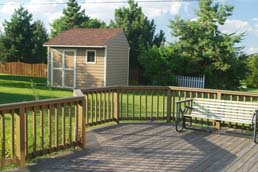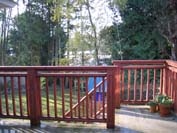Deck Railings 101
 Deck
railings and balusters serve as both decorative and functional components of any deck. Deck
railings and balusters serve as both decorative and functional components of any deck.
Decorative because they can be used as a design element, reflecting the
architecture of the house or the surrounding landscape, and functional because
they are required safety features.
Replacing your deck railings is one of the easiest ways to give your tired
dated deck a facelift and in so doing add value to your home and enhance your
outdoor living space.
Deck railings are composed of top and bottom rails, side-rails, protruding
posts, balusters, and hand rails for deck stairs. Types of railings include:
aluminum and glass railing, PVC, composite, and wood railings, and decorative
inserts and panels.
Top and Bottom
Rails:
-
Top rails can be made from 2x4s
or 2x6s. They can be placed flat (horizontal) or on edge (vertical).
-
A 2x6 top rail has the benefit of
width and can be placed over top intermediate posts, resulting in a stronger
railing. If you allow for each post to protrude between deck railing
sections, then the posts will have to endure the most of any force as the
union between top rail and post will become the weakest link.
-
A smooth uninterrupted and
continuous top rail over the post tops tends to define the perimeter of a
deck more noticeably.
Posts:
-
Posts can be mounted on the
exterior of the rim joist and rise above each section of top rail to draw
attention.
-
Posts can also be set into the
inside of the rim joist and the posts either protrude above the top rail at
corners which defines the look of the deck’s periphery.
-
Posts that protrude above the top
rail at each section draw the eye toward them. Detail the post or dress it
up with a cap. Or, make every second post larger or wider.
Post Caps:
-
Post caps provide a professional
finished look to posts that protrude about the top rail. They are available
in many styles, from simple to ornamental.
-
Lighted post caps provide added
safety and decoration at night.
Balusters and Pickets:
-
Balusters (also called pickets or
spindles) are the vertical members between the top and bottom rails.
-
Wide balusters or pickets create
a more closed in heavier space, which may be desirable if you want to
obscure a view or if your home’s architecture has a heavier structure to it.
-
Thin pickets create the
perception of openness and accentuate the view. You can alternate narrower
and wider balusters to create and interesting visual contrast.
-
Aluminum, steel or wrought iron
balusters give a less obtrusive look. They can be thinner because they are
so strong and give you a more open view.
-
Baluster spacing should not
exceed 4” from inside edge to inside edge, but check with local building
codes to be sure. In addition, most building codes prohibit horizontal
balustrades because they facilitate climbing.
Handrails:
A hand rail has to be small enough
that a person can easily grasp the rail with their hand.
Panels:
Glass panels let you capitalize on views ? Semi-transparent panels provide
privacy while allowing for maximum light ? Louvered panels between posts offer a
very contemporary look and style and lend themselves perfectly to interior
lighting. ? Side panels with matching siding stucco provide privacy.
Color:
- Accentuate deck railings by staining the top rail or posts a different
color than the balusters.
For more information on decks and deck railings, please read this article on
deck railing designs.
More Articles...
|




